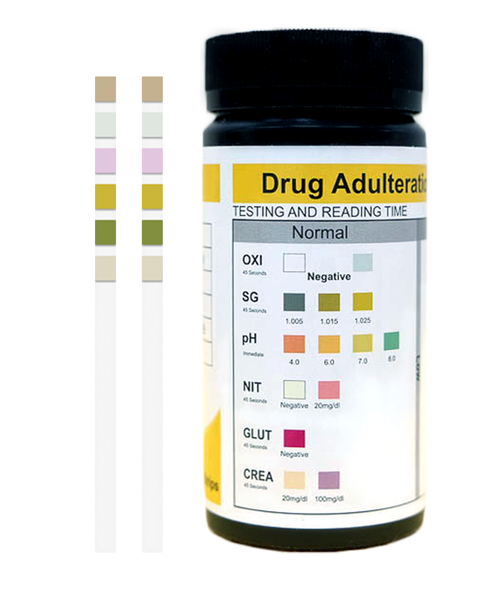Description
UrineCheck-7 is design to indicate when a urine sample has been diluted or adulterated. Simply dip into the sample and read color results by comparison to chart on the bottle.
DETECTS
- Creatinine
- Nitrite
- Glutaraldehyde
- pH
- Specific Gravity
- Bleach
- Pyridinium Chlorochromate
Popular Adulterants Detected: Stealth, Whizzes, Clear Choice, Lucky Lab LL418, Clean-x, Bleach, Vinegar, Urine luck 6.3 & 6.4, Klear, Instant Additive, Purafyzit, Drano, Liquid hand soap, and Detoxify Cleaners
PURPOSE OF URINECHECK-7 ADULTERATION TEST
The UrineCheck 7 design is to combat the adulteration problem with 7 different test parameters. UrineCheck 7 adulteration test strips test for tampered urine and detects the adulterants on-site before they become undetectable. Consisting of 7 parameters, Intect 7 tests for creatinine, nitrite, glutaraldehyde, pH, specific gravity, and 2 oxidants including bleach and pyridinium chlorochromate.
TEST PRINCIPLE
In general, all seven tests are based on the chemical reactions of the indicator reagents on the pads with components in the urine sample effecting color changes. Results are obtained by comparing the color on each of the test pads with the corresponding pad on the container color chart label.
Creatinine: Testing for sample dilution. In this assay, creatinine reacts with a creatinine indicator in an alkaline condition to form a purplish-brown color complex. The concentration of creatinine is directly proportional to the color intensity of the test pad.
Glutaraldehyde: Testing for the presence of exogenous aldehyde. In this assay, the aldehyde group on the glutaraldehyde reacts with an indicator to form a pink/purple color complex.
Nitrite: Testing for the presence of exogenous nitrite. Nitrite reacts with an aromatic amine to form a diazonium compound in an acid medium. The diazonium compound in turn couples with an indicator to produce a pink-red/purple color.
Oxidants: Testing for presence of oxidizing reagents. In this reaction, a color indicator reacts with oxidants such as hydrogen peroxide, ferricyanide, persulfate, or pyridinium chlorochromate to form a blue color complex. Other colors may indicate the presence of other oxidants.
pH: Testing for the presence of acidic or alkaline adulterant. This test is based on the well-known double pH indicator method that gives distinguishable colors over wide pH range. The colors range from orange (low pH) to yellow and green to blue (high pH).
Specific Gravity: Testing for sample dilution. This test is based on the apparent pKa change of certain pretreated polyelectrolytes in relation to the ionic concentration. In the presence of an indicator, the colors range from dark blue or blue-green in urine of low ionic concentration to green and yellow in urine of higher ionic concentration.
Bleach: Testing for the presence of bleach in urine. In this test, the presence of bleach forms a blue-green color complex.
Pyridium Chlorochromate: Testing for the presence of chromate in urine. In this test, the presence of chromate forms a blue-green color complex.
UrineCheck 7 is the most effective screen for validity testing on the market. 7 parameter urine adulteration test. 25 adulteration test strips per bottle. Adulteration test strips serve to insure specimen validity.
FEATURES
- Accurate, Most Comprehensive Test Available
- Detects Adulteration, Dilution, and Substitution
- Simple To Use And Interpret
- Results in 1 minute
- No instrumentation required
- Conforms to DOT guidelines










